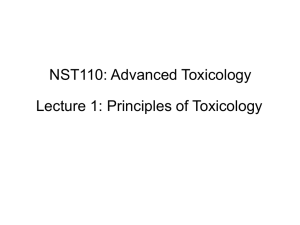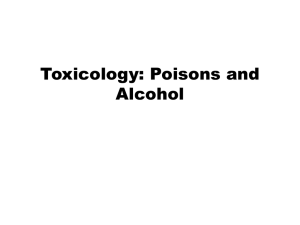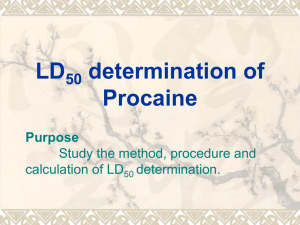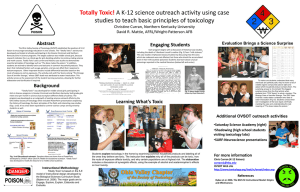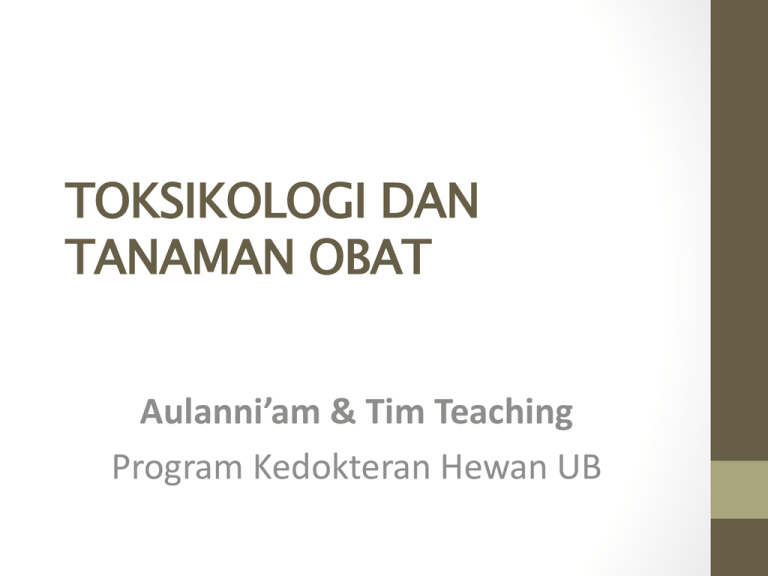
TOKSIKOLOGI DAN
TANAMAN OBAT
Aulanni’am & Tim Teaching
Program Kedokteran Hewan UB
Kode / SKS
: PKH4504/ 2 SKS
Prasyarat : Farmakologi Veteriner
(PKH4401)
Status Mata Kuliah: Wajib
What is toxicology?
Superman
The Mercury Cycle
toxic compounds
physical agents
`
toxicology …………
• Is the study of the harmful effects
of chemicals and physical agents on
living organisms
• Examines adverse effects ranging
from acute to long-term
toxicology …………
`
• Is used to assess the probability of
hazards caused by adverse effects
• Is used to predict effects on
individuals,
populations
and
ecosystems
These adverse effects may occur in many
forms, ranging from immediate death to subtle
changes not realized until months or years
later.
They may occur at various levels within the
body, such as an organ, a type of cell, or a
specific biochemical.
Sources of toxic compounds
Synthetic organic compound
1. Air, water, and food pollutants
Air- CO, oxides of nitrogen, oxides of sulfur,
hydrocarbons and particulates
Water-agricultural chemicals including pesticides,
herbicides, fugicides, nematocides, rodenticides,
fertilizer
Halogenated
hydrocarbonschloroform,
dichloroethane, tetrachloride
Clorinated aromatics-PCB, TCDD
Detergents-alkyl benzene sulfonates
2. Chemical additives in food
As preservatives-antibacterial, antifungal,
or antioxidant
To change physical characteristics, taste,
color, odor
3.Chemicals in work place
Inorganics-metals and flurides, CO, etc.
Organic compounds-aliphatic hydrocarbons
(hexene) aromatic hydrocarbons (eg. benzene,
toluene)
.
halogenated hydrocarbons
alcohols
esters
organometallics
amino compounds
4. Drugs of abuse
CNS depressants-ethanol,secobarbital
CNS stimulants-cocaine,
methamphatamine,
nicotine, caffeine
.
Opioids-heroin, morphine
Hallucinogens-PCP, LSD,THC
5.Therapeutic drugs
The danger to the individual depends on :
the nature of the toxic response
the dose necessary to produce the toxic response
the relationship between the therapeutic dose and
the toxic dose
eg, anticancer drugs are carcinogens
Diethylstilbestrol (DES)
Thalidomide
Chloroquinol-SMON-subacute myelo-optic
neuropathy
Methyldopa, chloropromazine, methotrexate
In general, toxic side effects are not common and may
occur only in susceptible individuals or
populations.
6. Pesticides
Classes Of Pesticides
Insecticides (kill insects)
•
•
•
•
Organochlorines
Organophosphates
Carbamates
Synthetic Pyrethroids
Herbicides (kill plants)
Rodenticides (kill rodents)
Fungicides (kill fungus)
Fumigants (kill whatever)
6. Pesticides
7. Solvents
8. Polycyclic aromatic hydrocarbons (PAH)
Incomplete combustion of organic materials, in
smoke from wood, coal, oil, tobacco, in tar and
broiled foods
Carcinogens
9. Cosmetics
Allergic reactions and contact dermatitis
Bromate, cold-wave neutralizer
Thioglycolates and tioglycerol-cold-wave lotion and
depilatories
Sodium hydroxide-hair straighteners
Naturally occurring toxins
1. Mycotoxins
2. Microbial toxins
3. Plant toxins
4. Animal toxins
"Toxin"=refers to toxic substances that
are produced naturally
"Toxicant"=substance that is produced by
anthropogenic origin
An interdisciplinary field…………
Descriptive Toxicology
Mechanistic Toxicology
Regulatory Toxicology
Dose / Response
Risk =
Hazard X Exposure
Individual Sensitivity
Effects of Amount on Response
Effects of Size on Response
Agent
Ethyl alcohol
Salt (sodium chloride)
Iron (Ferrous sulfate)
Morphine
Mothballs
(paradichlorobenzene)
Aspirin
DDT
Cyanide
Nicotine
Tetrodotoxin (from fish)
Dioxin (TCDD)
Botulinum Toxin
Bee Venom
LD-50 (mg/kg)
10,000
4,000
1,500
900
500
250
250
10
1
0.01
0.001
0.00001
??
Descriptive Toxicology:
The science of toxicity testing to
provide
information
for
safetyevaluation
and
regulatory
requirements.
Toxicology Definitions
The study of poisons
or
the adverse effects of chemical and
physical agents on living organisms.
An Individual View
“The sensitivity of the individual
differentiates a poison from a remedy. The
fundamental principle of toxicology is the
individual’s response to a dose.”
S. G. Gilbert (1997)
Mechanistic Toxicology:
Identification and understanding
cellular, biochemical and
molecular
basis
by
which
chemicals exert toxic effects.
Regulatory Toxicology:
Determination
of
risk
based
on
descriptive and mechanistic studies,
and developing safety regulations.
Clinical Toxicology:
Diagnosis and treatment of poisoning;
evaluation of methods of detection and
intoxication, mechanism of action in humans
(human tox, pharmaceutical tox) and animals
(veterinary tox). Integrates toxicology,
clinical
medicine,
clinical
biochemistry/pharmacology.
.
Occupational Toxicology:
Combines
occupational
occupational hygeine.
medicine
and
Environmental Toxicology:
Integrates toxicology with sub-disciplines
such as ecology, wildlife and aquatic biology,
environmental chemistry.
The scope of toxicity
A. Mechanisms of Toxic Action
1. Biochemical toxicology
2. Behavioral toxicology-behavior is the final
integrated expression of nervous function
3. Nutritional toxicology-the effects of diet
4. Carcinogenesis-cell growth
5. Teratogenesis-developmental process
6. Mutagenesis-genetic material
7. Organ toxicity-organ function
B. Measurement of toxicants and toxicity
1. Analytic toxicology
2. Toxicity testing
3. Toxicologic pathology
4. Structure-activity study
5. Biomathematics and statistics
6. Epidemiology
C. Applied Toxicology
1. Clinical toxicology
2. Veterinary toxicology
3. Forensic toxicology
4. Environmental toxicology
5. Industrial toxicology
D. Chemical use classes
1. Agricuture chemicals
2. Clinical drugs
3. Drugs of abuse
4. Food additives
5. Industrial chemicals
6. Naturally occurring substancesphytotoxin, mycotoxin, inorganic minerals
7. Combustion products
E. Regulatory Toxicology
1. Legal aspects-formulation of laws
and regulations and their enforcement
2. Risk assessmentthe definition of risks, potential risks
and risk- benefit equations
F. Development of antidotes
Toxic Effects
1. Immediate effect and delayed effect
CO, cyanide
2. Local effect and systemic effect
target organ
3. Reversible and irreversible effect
4. Anaphylactic reaction (allergic reaction)
5. Idiosyncratic reaction
Dose
Dose by definition is the amount of a substance
administered at one time.
However, other parameters are needed to characterize
the exposure to xenobiotics.
The most important are the number of doses, frequency,
and
total
time
period
of
the
treatment.
For example:
650 mg Tylenol as a single dose
500 mg Penicillin every 8 hours for 10 days
10 mg DDT per day for 90 days
A common dose measurement is mg/kg body weight.
The commonly used time unit is one day and thus, the
usual dosage unit is mg/kg/day.
Environmental exposure units are expressed as the
amount of a xenobiotic in a unit of the media.
mg/liter (mg/l) for liquids
mg/gram (mg/g) for solids
mg/cubic meter (mg/m3) for air
Other commonly used dose units for substances in
media are parts per million (ppm), parts per billion (ppb)
and parts per trillion (ppt).
Fractionating a total dose usually decreases the
probability that the total dose will cause toxicity.
The reason for this is that the body often can
repair the effect of each subtoxic dose if
sufficient time passes before receiving the next
dose.
In such a case, the total dose, harmful if
received all at once, is non-toxic when
administered over a period of time.
For example, 30 mg of strychnine swallowed at
one time could be fatal to an adult whereas 3 mg
of strychnine swallowed each day for ten days
would
not
be
fatal.
vinyl chloride,
high dose-hepatotoxicant
long latent period at lower doses-carcinogen
very low dose-no effect
aspirin
chronic use-deleterious effects on the gastric
mucosa, fatal dose 0.2-0.5 g/kg
metals
dietary
essentials
eg.
Iron,
copper,
magnesium,
cobalt, manganese, and zinc
toxic at higher dose
"All substances are poisons; there is
none which is not a poison.
The right dose differentiates a poison
and a remedy.“
Paracelsus (1493-1541)
Knowledge of the dose-response relationship:
establishes causality that the chemical has in fact
induced the observed effects
establishes the lowest dose where an induced effect
occurs - the threshold effect
determines the rate at which injury builds up - the
slope for the dose response.
Dose Response
Individual, or graded, dose-response relationship
results from an alteration of a specific
biochemical process
Quantal dose-response relationship
in a population-”all or none”
determination of the LD50
LD (lethal dose)50-the dose required to kill 50% of a
population of an organism under stated conditions
Normal equivalent deviations(NEDs)
NED for 50% response is 0
NED for 84.1% response is 1
Probit (probability unit)=NED+5
LD50 is used to:
A) classify substances or products for regulatory
purposes including safe transportation and labeling,
B) provide information for treatment of acute
intoxications
C) standardize certain biological products,
D) set dose levels for subsequent toxicity studies
E) provide comparative information on the
chemical's dose response curve
F) provide data for evaluation and validation of
alternative test methods.
Classical LD50
The Classical LD50 test is used to determine
the lethal dose (LD50) of a substance that will
kill 50% of test animals.
Typically, this method can use 100 or more
animals.
The test material is administered in increasing
doses, usually 5 or more, to groups of 10 male
and 10 female animals.
Mortalities are recorded within a given period,
and the LD50 is determined with the aid of
statistical calculations.
2. Limit Test
Acute toxicity test in which, if no ill-effects occur
at a pre-selected maximum dose, no further
testing at greater exposure levels is required.
Five to ten animals of each sex or 10 animals of
the susceptible sex are administered a dose
specified by regulations.
Toxic responses occurring within a given period
are recorded. Based on the results, a regulatory
action or additional testing may be required.
The LD50 tests have become controversial
among toxicologists, animal welfare
organizations, legislators and the public
primarily due to the ethics of using a large
number of animals and evaluating only
mortality.
CURRENT POLICIES
Food and Drug Administration:
•Does not require the use of the Classical
LD50 test.
•Accepts alternatives.
•Refers to the Limit test.
Organization for Economic Cooperation and
Development:
•Discourages the use of Classical LD50 test.
•Recommends the Limit test (2 g/kg dose).
•When compound related mortality occurs in
the limit test, then 5 animals per dose, at least 3
dose levels are used to produce a range of
toxic effects and mortality rates; clinical
observations and pathological investigations
are conducted.
•A fixed dose procedure, which uses morbidity
instead of mortality as the end point, is also
recommended.
British Toxicology Society:
•The LD50 should only be determined with any
accuracy where scientifically and ethically justified.
Such cases are relatively rare.
•Examination of few animals in detail rather than
many for statistical purposes.
•Limit tests could be used, provided animals in
distress are killed humanely, if this would not
interfere with the objectives.
•For classification of substances and preparations,
a fixed-dose procedure targeted to acute signs
could replace the current practice of LD50
determination.
Descriptive animal toxicity tests
Two main principle
1. The effects produced by a compound in
laboratory animals, when properly qualified,
are applicable to humans.
2. The exposure of experimental animals to
toxic agents in high dose is necessary and
valid method of discovering possible hazards
in human.
Descriptive animal toxicity tests
Acute Single dose with effects occurring for a short
period of time (usually up to 96 hr)
Acute lethality (die in a 14-day period)
LD50 (Median Lethal Concentration)
Skin & eye irritation
sensitization
Subacute Multiple doses administered for up to
days
14
Subchronic Continuous dosing for up to 90 days
NOAEL-no observed adverse effect level
Chronic Continuous dosing for up to 6 months to 2
years
carcinogenic potential
• Acute effects do not predict chronic effects
• Doses causing chronic effects may not cause
acute or sub-acute effects
• Chronic effects of a chemical exposure may
manifest themselves as a common disease and go
unnoticed
Course Objectives
Understand…….
• mechanisms by which chemicals cause cell
injury and cell death
• the mode of action of specific organic and
inorganic chemicals
• how to interpret results of in vitro tests for
the evaluation of in vivo toxicity
• How multiple chemical exposures and other
stressors can alter toxicity
• What factors influence individual
susceptibility
• the importance of dose in determining
adverse effects
of chemicals
• what factors influence the target organ
dose of a chemical
• mechanisms by which chemicals affect
specific organ system functions




